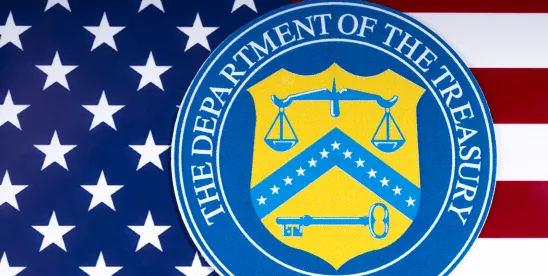The U.S. Department of the Treasury (“Treasury”) recently issued a Notice of Proposed Rulemaking (“NPRM”), setting the stage for regulation of certain U.S. outbound investment in China and China-linked companies. This NPRM is the latest phase of Treasury’s rulemaking on outbound investment, following Executive Order (“EO”) 14105 and an Advanced Notice of Proposed Rulemaking (“ANPRM”) that was the subject of a previous Blank Rome client alert. The NPRM presents draft regulations on this topic for the first time. The period for public comment on the NPRM closes on August 4, 2024.
Treasury’s June 21, 2024, NPRM seeks to regulate certain U.S. investment in China and China-linked companies based on concerns that U.S. capital and associated “intangible benefits”—such as managerial assistance, enhanced standing, and access to talent networks—could aid China in developing technologies that threaten U.S. national security. The NPRM would apply to “covered transactions;” i.e., those in which a U.S. person or U.S.-owned investor has “knowledge” that the Chinese or China-linked investment target has certain connections with semiconductors, artificial intelligence (“AI”), or quantum technologies that would be subject to a notification requirement or prohibited outright. For further information, see Treasury’s Fact Sheet.
It is important to note that the NPRM is still just a proposal, with no final rule yet on the horizon. Treasury may not issue final regulations for months and perhaps not until next year, and it should be noted that a change in presidential administrations (if one occurs) could delay a final rule and its implementation.
The NPRM contains the following key elements:
- Application to U.S. persons / U.S.-owned entities: The NPRM would apply to U.S. persons—defined as U.S. citizens, U.S. permanent residents, persons located in the United States, and U.S.-incorporated entities and their non-U.S. branches—as well as any non-U.S. entity of which a U.S. person is a “parent” (known as a “controlled foreign entity”).
- Knowledge standard / diligence expectation: The NPRM would apply to transactions in which the investor knows or reasonably should have known, through a “reasonable and diligent inquiry,” that the investment target is a “covered foreign person.”
- Specific categories of covered transactions: A “covered transaction” is any transaction that a U.S. person knows involves a “covered foreign person” and includes the following:
- An acquisition of an equity or contingent equity interest;
- Certain debt financing that is convertible to an equity interest or that affords certain rights to the lender;
- The conversion of a contingent equity interest;
- A greenfield investment or other corporate expansion;
- A joint venture; and
- Certain investments as a limited partner (“LP”) or equivalent in a non-U.S. person pooled investment fund.
- Covered activities: The NPRM identifies a “covered activity” to mean any activity defined as a “notifiable transaction” or “prohibited transaction.”
- Notifiable Transaction: A transaction involving technologies, identified in detail below, “that may contribute to the threat to the national security of the United States.”
- Prohibited Transaction: A transaction involving technologies, identified in detail below, “that pose a particularly acute national security threat.”
- Countries of concern: As identified in an Annex to EO 14105, the President has designated the People’s Republic of China as a “country of concern,” along with Hong Kong and Macau.
- Person of a country of concern: The NPRM expansively defines a “person of a country of concern” to include a range of Chinese persons and China-linked entities outside of China, including:
- An individual who is a citizen or permanent resident of a “country of concern;”
- An entity with a principal place of business in, headquartered in, or organized in a “country of concern;”
- The government of a “country of concern,” including state-owned enterprises;
- An entity owned 50 percent or more by one or more of the persons above, regardless of location; or
- Going one step further, an entity owned 50 percent or more by one of the majority-owned entities described above, regardless of location.
- Covered foreign persons: A “covered foreign person” is defined as:
- A “person of a country of concern” that is engaging in a covered activity.
- A person, including those not from a “country of concern” or engaged in a covered activity, who:
- holds any voting interest, board seat, or equity interest in a person of a country of concern that engages in a covered activity, and
- derives more than 50 percent of its revenue or net income from, or incurs more than 50 percent of its capital expenditure or operating expenses through, a person of a “country of concern” that is engaging in a covered activity.
- Excepted transactions: Per Treasury’s Fact Sheet, the NPRM proposes excepting several types of transactions from the rules’ coverage, to include:
- Investments in publicly traded securities;
- LP investments of a certain size;
- Full buyouts of all country of concern ownership of an entity;
- Intracompany transactions between a U.S. parent and a majority-controlled subsidiary to support ongoing operations or other non-covered activities;
- Transactions pursuant to binding, uncalled capital commitments entered into prior to August 9, 2023;
- Transactions in which a U.S. person, as a member of a lending syndicate, acquires a voting interest in a covered foreign person upon default, and the U.S. person cannot initiate any action vis-à-vis the debtor and does not have a lead role in the syndicate; and
- Certain transactions outside of the United States in which Treasury determines that the relevant country sufficiently is addressing national security concerns posed by outbound investment.
- National interest exemption: Under the proposed rule, a U.S. person may seek a “national interest” exemption determination for transactions that are “in the national interest of the United States.” Treasury anticipates detailing the process and required information for an exemption at a later date.
- Notifiable and prohibited transactions:
- As noted above, certain covered transactions would be notifiable (i.e., trigger a notification requirement), while certain others that present a particularly acute national security threat would be prohibited outright.
- A U.S. person subject to the notification requirement under the proposed rule must submit a notification to Treasury no later than 30 days after (1) the transaction is completed, or (2) the U.S. person acquires knowledge (or reasonably should have known through appropriate due diligence) that the transaction would have been a covered transaction.
Notably, the NPRM provides that the rules do “not entail a case-by-case review by the Department of the Treasury of covered transactions or any other transactions, nor does it establish a licensing process where a U.S. person would seek prior authorization for a covered transaction.” Rather, the NPRM requires U.S. persons to determine whether certain transactions are “prohibited, permissible but subject to notification, or not covered by the rule.”
Covered Technologies
As identified, above, the NPRM pertains to three types of technologies subject to investment prohibition or notification. Specifically, this includes:
Semiconductors/Microelectronics
- Prohibition: Electronic design operation software; certain front-end semiconductor fabrication equipment; certain volume advanced packaging equipment; design, fabrication, and packaging of certain advanced integrated circuits; supercomputers enabled by certain advanced integrated circuits
- Notification: Integrated circuit design, fabrication, and packaging not otherwise covered by the prohibited transaction definition
Quantum Information Technologies
- Prohibition: Development of a quantum computer; production of any critical elements required to produce a quantum computer; development or production of certain quantum sensing platforms; development or production of certain quantum network or quantum communication systems
- Notification: None
Artificial Intelligence
- Prohibition: Certain AI systems designed to be exclusively used for, or which the relevant covered foreign person intends to be used for, any military, government intelligence, or mass-surveillance end uses
- Notification: Development of AI systems not otherwise covered by the prohibited transaction definition that are designed for any (i) military, government intelligence, or mass-surveillance end users; (ii) end users who intend to use the systems for certain applications; and (iii) trained using a specified quantity of computing power
Enforcement
Violations of the NPRM are subject to civil and criminal penalties under the International Economic Emergency Powers Act (“IEEPA”). Violations of IEEPA are punishable by civil penalties of up to the greater of ~$368,000 (annually adjusted for inflation) or twice the value of the transaction at issue, and criminal penalties of up to $1 million and/or 20 years’ imprisonment. In addition, Treasury may force the divestment of a prohibited investment. Notably, the NPRM would authorize any person who has violated the regulations to submit to Treasury a voluntary self-disclosure.
Takeaways
The NPRM is an essential step towards regulating outbound U.S. investments with a link to Chinese technology development, which has been proposed in various forms for years. The following are particularly notable regarding the NPRM:
- The focus is on integrated circuits, AI, and quantum—three technologies that are at the apex of U.S. national security concerns. The NPRM is not intended to cover all investments with a China nexus.
- Where an investment presents a link with the above technologies, the scope of the NPRM is quite broad, applying to:
- Investment by U.S. persons and non-U.S. entities they own or control;
- Direct or indirect investments in Chinese entities, Chinese-owned entities outside of China, and entities owned by Chinese-owned entities outside of China;
- Investments in the above targets that themselves are engaged in relevant activity involving the technologies noted above, or in targets that are invested in other companies engaged in such activity.
- The effect of this is that, where an investment could even tangentially involve one of the technologies at issue, U.S. and U.S.-owned investors may need to conduct extensive diligence, covering multiple degrees of separation, to assess whether the transaction is prohibited or notifiable.
- The NPRM reinforces this through the knowledge standard, which imputes to investors what they should have known through a “reasonable and diligent inquiry.”
- Violations of the NPRM would be subject to potentially significant IEEPA penalties and, for prohibited transactions, unwinding of the transaction.
- The NPRM is still just a proposal as of this time, and industry comments and presidential politics are likely to impact the content and timing of any final rule.






 />i
/>i

